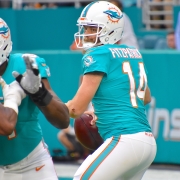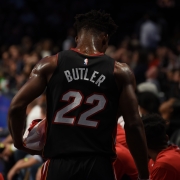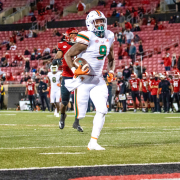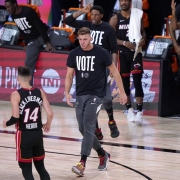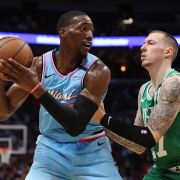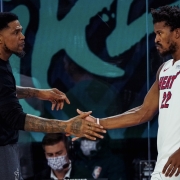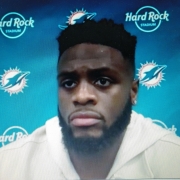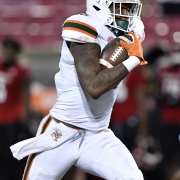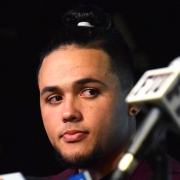Pressure Point: FitzMagic brings much-needed joy in Dolphins win
Well, that was fun.
For the love of Fitz, how often has it been possible to express that sentiment about any Miami Dolphins game during the past two decades?
Just when it was needed most, 37-year-old boy wonder Ryan Fitzpatrick led the Dolphins to a 31-13 rout of the Jacksonville Jaguars in a Thursday night performance that was as joyous as effective.
Big picture conclusions should be avoided from any given game in the NFL. But coming on the heels of troubling opening losses to the Patriots and Bills, it was a relief to allay fears of another season-killing opening winless stretch like Miami’s 0-7 start last season.
And the “We want Tua” chants can remain on hold for awhile.
Tua Tagovailoa’s time will come soon enough, and hopefully he will prove to be the wunderkind of Dolfans dreams.
Right now, this is Fitzpatrick’s team and there is no question about that in the locker room.
Tight end Mike Gesicki said: “Yeah, I mean Fitz is out of his mind. He’s [37] years old and still playing this game like he’s 23. But to have him as our leader and for you to see the fun that he has — after I scored my touchdown we just came off to the sideline and just started yelling and screaming and chest bumping; it’s so fun to play with him.”
Sure, Fitzpatrick is averaging more than an interception a game in his long career with eight teams. He may throw up three picks any given day, as he did in the opener at New England.
More about Fitzpatrick and the Dolphins’ win at Five Reasons Sports
Fitzpatrick can be ‘crazy’ good
Then he turns on that old FitzMagic and has a night for the ages as he did Thursday, opening with 12 consecutive completions. Added to the nine in a row to conclude Sunday’s loss against Buffalo, Fitz’s streak of 21 was second-longest in Dolphins history behind Ryan Tannehill’s 25, which is also tied for the NFL record.
Fitzpatrick completed 18 of 20, including two for touchdown, ran for another score and even caught one of his own deflected passes.
What stood out apart from the stats was the crazed celebration after bowling Csonka-like into the endzone for a third-quarter touchdown that blew the game open — confirming Gesicki’s “Fitz is out of his mind” affirmation.
Fitzpatrick put it in perspective afterward: “I feel like the luckiest guy in the world being able to go outside and play football with my friends.”
Ryan Fitzpatrick is your 'normal guy' living the dream 🙌 pic.twitter.com/46SgeKoIyV
— Gridiron (@Gridiron) September 25, 2020
Cleary, Tua couldn’t have a better role model to prepare for when he gets the keys to the franchise.
No question, this Dolphins season is still more about the future than the present. This is the first forward step in a rebuilding process (last season was the teardown that began it).
Some exterior walls have been set on a foundation, but it remains to be seen how the finished product will look — it will never be finished, of course.
There will be sobering Sundays ahead for the Dolphins. They’ve got more tough opposition coming up the next two weeks with the Seahawks and 49ers.
The Jaguars aren’t on the level of the Patriots and Bills, but they were favored, and rightfully so at home in prime time of a short week for both teams.
Offense shows positive signs
We began the season with the perspective of looking for progress. And for an indication that the approach of coach Brian Flores and general manager Chris Grier in constructing this team and Flores in coaching it is well founded.
The first two games were not encouraging. The defense, despite an extensive makeover, was atrocious. High-priced veterans signed in free agency played like suspects rather than upgrades.
The first encouraging signs are with the offense, and if began in the second half against the Bills.
Over the past six quarters, Fitz and Co. have produced 508 yards and 41 points.
QB Ryan Fitzpatrick was the highest-graded #Dolphins player in last night's victory over Jacksonville
– 91.5 overall
– Perfect 158.3 passer rating under pressure
– 8 different players caught a pass (including himself)
– 38 rushing yards (20 after contact)#FinsUp #MIAvsJAX pic.twitter.com/EKw0TI2kjD
— Ryan Smith (@PFF_RyanSmith) September 25, 2020
The reconstructed offensive line, with right tackle Jesse Davis the only holdover, is showing potential of a solid unit. Rookie linemen Austin Jackson and Solomon Kindley are looking more comfortable each week.
Neither rookie has allowed a sack in three games. Commendable, considering they had no preseason games to get acclimated.
The Dolphins rushed for more than 100 yards for the first time this season, with a 138. They need to improve on the average of 3.8 yards a carry — even that was inflated by a 29-yard run by wideout Jakeem Grant.
That Myles Gaskin (66 yards on 22 carries at Jacksonville) has emerged as the surprise featured back is an endorsement to building through the draft rather than free agency. Veteran offseason signees Jordan Howard and Matt Breida combined for five yards on six carries and have done little in three games.
High-flying Gesicki catches on
The biggest revelation on offense is Gesicki, the 2018 second-round pick who was the target of criticism as a rookie and the first half of his second season. But since late November the lanky former Penn State Nittany Lion has seven touchdown catches, tied for most in the NFL in that span.
Gesicki’s latest was another leaping masterpiece, which gave the Dolphins a 21-7 lead. Hopefully he will be a popular target for Tua for years to come. For now, he has become a favorite of Fitz, especially in the red zone.
The heaviest lifting remains on defense, though the unit was much better against the Jaguars, including four sacks. Several of the offseason acquisitions had more of an impact than in previous weeks. Linebacker Kamu Grugier-Hill had seven tackles including a sack. Kyle Van Noy forced a fumble and recovered it in the scramble. Shaq Lawson had six pressures.
Notably, rookie cornerback Noah Igbinoghene found some redemption in coverage after getting undressed by Bills receiver Stefon Diggs.
Veteran corner Xavien Howard had an interception, but is not back to pre-injury level in pass coverge.
Better teams will continue to expose the shortcomings of this defense. Tackling remains surprisingly shoddy for a Flores team.
But for one night the Dolphins had reason to pose and puff out their chests.
For Dolfans, it was a game that left you wanting more — more celebratory screams. More quirky, crazy FitzMagic.
Craig Davis has covered South Florida sports and teams, including the Dolphins, for four decades. Follow him on Twitter @CraigDavisRuns
Ryan Fitzpatrick is a true national treasure!! #MiamiDolphins #FinsUp pic.twitter.com/d12wVWIjw2
— Big E (@ian693) September 25, 2020
